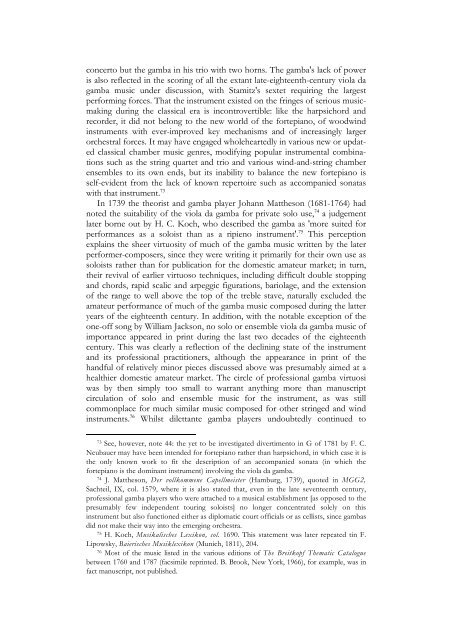download.pdf - 1.2Mb - Viola da Gamba Society
download.pdf - 1.2Mb - Viola da Gamba Society
download.pdf - 1.2Mb - Viola da Gamba Society
Create successful ePaper yourself
Turn your PDF publications into a flip-book with our unique Google optimized e-Paper software.
concerto but the gamba in his trio with two horns. The gamba's lack of power<br />
is also reflected in the scoring of all the extant late-eighteenth-century viola <strong>da</strong><br />
gamba music under discussion, with Stamitz's sextet requiring the largest<br />
performing forces. That the instrument existed on the fringes of serious musicmaking<br />
during the classical era is incontrovertible: like the harpsichord and<br />
recorder, it did not belong to the new world of the fortepiano, of woodwind<br />
instruments with ever-improved key mechanisms and of increasingly larger<br />
orchestral forces. It may have engaged wholeheartedly in various new or up<strong>da</strong>ted<br />
classical chamber music genres, modifying popular instrumental combinations<br />
such as the string quartet and trio and various wind-and-string chamber<br />
ensembles to its own ends, but its inability to balance the new fortepiano is<br />
self-evident from the lack of known repertoire such as accompanied sonatas<br />
with that instrument. 73<br />
In 1739 the theorist and gamba player Johann Mattheson (1681-1764) had<br />
noted the suitability of the viola <strong>da</strong> gamba for private solo use, 74 a judgement<br />
later borne out by H. C. Koch, who described the gamba as 'more suited for<br />
performances as a soloist than as a ripieno instrument'. 75 This perception<br />
explains the sheer virtuosity of much of the gamba music written by the later<br />
performer-composers, since they were writing it primarily for their own use as<br />
soloists rather than for publication for the domestic amateur market; in turn,<br />
their revival of earlier virtuoso techniques, including difficult double stopping<br />
and chords, rapid scalic and arpeggic figurations, bariolage, and the extension<br />
of the range to well above the top of the treble stave, naturally excluded the<br />
amateur performance of much of the gamba music composed during the latter<br />
years of the eighteenth century. In addition, with the notable exception of the<br />
one-off song by William Jackson, no solo or ensemble viola <strong>da</strong> gamba music of<br />
importance appeared in print during the last two decades of the eighteenth<br />
century. This was clearly a reflection of the declining state of the instrument<br />
and its professional practitioners, although the appearance in print of the<br />
handful of relatively minor pieces discussed above was presumably aimed at a<br />
healthier domestic amateur market. The circle of professional gamba virtuosi<br />
was by then simply too small to warrant anything more than manuscript<br />
circulation of solo and ensemble music for the instrument, as was still<br />
commonplace for much similar music composed for other stringed and wind<br />
instruments. 76 Whilst dilettante gamba players undoubtedly continued to<br />
73 See, however, note 44: the yet to be investigated divertimento in G of 1781 by F. C.<br />
Neubauer may have been intended for fortepiano rather than harpsichord, in which case it is<br />
the only known work to fit the description of an accompanied sonata (in which the<br />
fortepiano is the dominant instrument) involving the viola <strong>da</strong> gamba.<br />
74 J. Mattheson, Der vollkommene Capellmeister (Hamburg, 1739), quoted in MGG2,<br />
Sachteil, IX, col. 1579, where it is also stated that, even in the late seventeenth century,<br />
professional gamba players who were attached to a musical establishment [as opposed to the<br />
presumably few independent touring soloists] no longer concentrated solely on this<br />
instrument but also functioned either as diplomatic court officials or as cellists, since gambas<br />
did not make their way into the emerging orchestra.<br />
75 H. Koch, Musikalisches Lexikon, col. 1690. This statement was later repeated tin F.<br />
Lipowsky, Baierisches Musiklexikon (Munich, 1811), 204.<br />
76 Most of the music listed in the various editions of The Breitkopf Thematic Catalogue<br />
between 1760 and 1787 (facsimile reprinted. B. Brook, New York, 1966), for example, was in<br />
fact manuscript, not published.
















